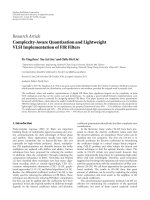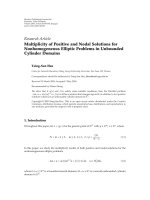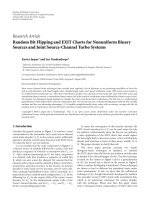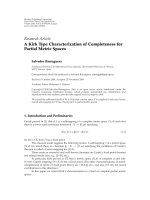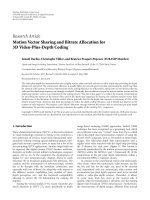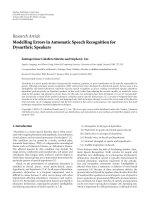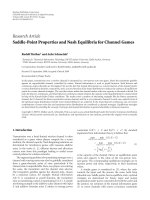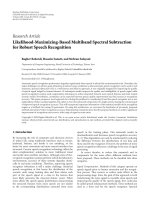Báo cáo hóa học: "Research Article Linearized Riccati Technique and (Non-)Oscillation Criteria for Half-Linear Difference Equations" docx
Bạn đang xem bản rút gọn của tài liệu. Xem và tải ngay bản đầy đủ của tài liệu tại đây (545.12 KB, 18 trang )
Hindawi Publishing Corporation
Advances in Difference Equations
Volume 2008, Article ID 438130, 18 pages
doi:10.1155/2008/438130
Research Article
Linearized Riccati Technique and (Non-)Oscillation
Criteria for Half-Linear Difference Equations
Ond
ˇ
rej Do
ˇ
sl
´
y
1
and Simona Fi
ˇ
snarov
´
a
2
1
Department of Mathematics and Statistics, Masaryk University, Jan
´
a
ˇ
ckovo n
´
am. 2a,
66295 Brno, Czech Republic
2
Department of Mathematics, Mendel University of Agriculture and Forestry in Brno, Zem
ˇ
ed
ˇ
elsk
´
a1,
61300 Brno, Czech Republic
Correspondence should be addressed to Ond
ˇ
rej Do
ˇ
sl
´
y,
Received 23 August 2007; Accepted 26 November 2007
Recommended by John R. Graef
We consider the half-linear second-order difference equation Δr
k
ΦΔx
k
c
k
Φx
k1
0, Φx :
|x|
p−2
x, p>1, where r, c are real-valued sequences. We associate with the above-mentioned equa-
tion a linear second-order difference equation and we show that oscillatory properties of the above-
mentioned one can be investigated using properties of this associated linear equation. The main tool
we use is a linearization technique applied to a certain Riccati-type difference equation correspond-
ing to the above-mentioned one.
Copyright q 2008 O. Do
ˇ
sl
´
y and S. Fi
ˇ
snarov
´
a. This is an open access article distributed under
the Creative Commons Attribution License, which permits unrestricted use, distribution, and
reproduction in any medium, provided the original work is properly cited.
1. Introduction
In this paper, we deal with oscillatory properties of solutions of the half-linear second-order
difference equation
Δ
r
k
Φ
Δx
k
c
k
Φx
k1
0, Φx : |x|
p−2
x, p > 1,
1.1
where r, c are real-valued sequences and r
k
> 0. This equation can be regarded as a discrete
counterpart of the half-linear differential equation
rtΦ
x
ctΦx0
1.2
which attracted considerable attention in the recent years. We refer to the books in 1, 2 and
the references given therein. The basic qualitative theory of 1.1 has been established in the
series of papers in 3–7 and it is summarized in the books 8, Chapter 3 and 2, Chapter 8.
2 Advances in Difference Equations
It is known that oscillatory properties of 1.1 are very similar to those of the second-order
Sturm-Liouville difference equation which is a special case of p 2in1.1:
Δ
r
k
Δx
k
c
k
x
k1
0.
1.3
In particular, the discrete linear Sturmian theory extends verbatim to 1.1, and hence this equa-
tion can be classified as oscillatory or nonoscillatory. We will recall elements of the oscillation
theory of 1.1 in more detail in the next section.
The basic idea of the discrete linearization technique which we establish in this paper is
motivated by the paper of Elbert and Schneider 9, where the second-order half-linear differ-
ential equation
Φ
x
γ
p
t
p
Φx2
p − 1
p
p−1
δt
t
p
Φx0,γ
p
:
p − 1
p
p
,
1.4
is viewed as a perturbation of the Euler-type half-linear differential equation
Φ
x
γ
p
t
p
Φx0,
1.5
and oscillatory properties of 1.4 are studied via the linear equation
ty
δt
t
y 0
1.6
under the assumption that
∞
t
δs/s ds ≥ 0forlarget. In particular, the following statements
are presented in 9.
i Let p ≥ 2 and let linear equation 1.6 be nonoscillatory. Then 1.4 is also nonoscillatory.
ii Let p ∈ 1, 2 and let half-linear equation 1.4 be nonoscillatory. Then linear equation 1.6
is also nonoscillatory.
The linearization technique for 1.2 has been further developed in 10–12; see also references
given therein.
In our paper, we introduce a similar linearization technique for the investigation of os-
cillatory properties of 1.1. This equation is regarded as a perturbation of the nonoscillatory
equation of the same form:
Δ
r
k
Φ
Δx
k
c
k
Φ
x
k1
0,
1.7
and oscillatory properties of solutions of 1.1 are related to those of the linear second-order
difference equation
Δ
R
k
Δy
k
C
k
y
k1
0,
1.8
where
R
k
2
q
r
k
h
k
h
k1
Δh
k
p−2
,C
k
c
k
− c
k
h
p
k1
,
1.9
O. Do
ˇ
sl
´
yandS.Fi
ˇ
snarov
´
a3
with q p/p − 1 being the conjugate number of p, and with a certain distinguished solution
h of 1.7. This enables to apply the deeply developed linear oscillation theory when investi-
gating oscillations of half-linear equation 1.1. As we will see in the next sections, compared
to the continuous case, the linearization technique is technically more difficult in the discrete
case since a nonlinear function which appears in the so-called modified Riccati equation is
considerably more complicated in the discrete case.
The paper is organized as follows. In the next section, we recall basic oscillatory proper-
ties of 1.1, including a quadratization formula for a certain nonlinear function which plays an
important role in subsequent sections of the paper. In Section 3, we present a discrete version
of the above-mentioned result of Elbert and Schneider 9.InSection 4, we show that under
certain additional restriction on properties of solutions of 1.7 we do not need to distinguish
between the cases p ≥ 2andp ∈ 1, 2. The last section of the paper is devoted to an application
of the results of the previous sections of the paper.
2. Preliminaries
Oscillatory properties of 1.1 are defined using the concept of the generalized zero which is
defined in the same way as for 1.3see, e.g., 8, Chapter 3 or 2, Chapter 7.Asolutionx of
1.1 has a generalized zero in an interval m, m
1 if x
m
/
0andx
m
x
m1
r
m
≤ 0. Since we suppose
that r
k
> 0 oscillation theory of 1.1 generally requires only r
k
/
0, a generalized zero of x in
m, m 1 is either a “real” zero at k m 1 or the sign change between m and m 1. Equation
1.1 is said to be disconjugate in a discrete interval m, n if the solution x of 1.1 given by the
initial condition x
m
0, x
m1
/
0, has no generalized zero in m, n 1. Equation 1.1 is said to
be nonoscillatory if there exists m ∈
N such that it is disconjugate on m, n for every n>m,and
it is said to be oscillatory in the opposite case.
If x is a solution of 1.1 such that x
k
/
0insomediscreteintervalm, ∞,thenw
k
r
k
ΦΔx
k
/x
k
is a solution of the associated Riccati-type equation
R
w
k
:Δw
k
c
k
w
k
1 −
r
k
Φ
Φ
−1
r
k
Φ
−1
w
k
0.
2.1
Moreover, if x has no generalized zero in m, ∞,thenΦ
−1
r
k
Φ
−1
w
k
> 0, k ∈ m, ∞.If
we suppose that 1.1 is nonoscillatory, among all solutions of 2.1 there exists the so-called
distinguished solution w which has the property that there exists an interval m, ∞ such that
any other solution w of 2.1 for which Φ
−1
r
k
Φ
−1
w
k
> 0, k ∈ m, ∞,satisfiesw
k
> w
k
,
k ∈ m, ∞. Therefore, the distinguished solution of 2.1 is, in a certain sense, minimal solution
of this equation near ∞.If w is the distinguished solution of 2.1, then the associated solution
of 1.1 given by the formula
x
k
k−1
jm
1 Φ
−1
w
j
r
j
2.2
is said to be the recessive solution of 1.1see 13. Note that in the linear case p 2asolution
x of 1.3 is recessive if and only if
∞
1
r
k
x
k
x
k1
∞.
2.3
4 Advances in Difference Equations
Our first statement presents a comparison theorem for distinguished solutions of 2.1
and 2.4 given below.
Lemma 2.1 see 13. Let 1.1 be nonoscillatory and let c
k
≥ c
k
for large k. Further, let w
k
, v
k
be
distinguished solutions of the corresponding generalized Riccati equations 2.1 and
R
v
k
:Δv
k
c
k
v
k
1 −
r
k
Φ
Φ
−1
r
k
Φ
−1
v
k
0,
2.4
respectively. Then there exists m ∈
Z such that w
k
≥ v
k
for k ∈ m, ∞. In particular, if c
k
≥ 0 and
∞
r
1−q
k
∞,then w
k
≥ 0 for large k.
The next statement relates nonoscillation of 1.1 to the existence of a certain solution of
the Riccati inequality associated with 2.1.
Lemma 2.2 see 2, Theorem 8.2.7. Equation 1.1 is nonoscillatory if and only if there exists a
sequence w
k
satisfying r
k
w
k
> 0 and
R
w
k
≤ 0
2.5
for large k.
The next statement is the discrete version of the generalized Leighton-Wintner oscillation
criterion. In this criterion, 1.1 is viewed as a perturbation of 1.7.
Lemma 2.3 see 13. Let h be the positive recessive solution of nonoscillatory equation 1.7.If
∞
c
k
− c
k
h
p
k1
∞,
2.6
then 1.1 is oscillatory.
The last auxiliary oscillation results of this section are Hille-Nehari non-oscillation cri-
teria for linear difference equation 1.3.
Lemma 2.4 see 14. Suppose that c
k
≥ 0, r
k
> 0,
∞
r
−1
k
∞,and
∞
c
k
< ∞.If
lim inf
k→∞
k−1
1
r
j
∞
jk
c
j
>
1
4
,
2.7
then 1.3 is oscillatory. If
lim sup
k→∞
k−1
1
r
j
∞
jk
c
j
<
1
4
,
2.8
then 1.3 is nonoscillatory.
O. Do
ˇ
sl
´
yandS.Fi
ˇ
snarov
´
a5
For the remaining part of this section, we suppose that 1.7 is nonoscillatory and we let
h be its solution such that h
k
> 0forlargek. Further, put
G
k
: r
k
h
k
Φ
Δh
k
2.9
and define the function
Hk,v : v r
k
h
k1
Φ
Δh
k
−
r
k
v G
k
h
p
k1
Φ
h
q
k
Φ
−1
r
k
Φ
−1
v G
k
. 2.10
Lemma 2.5. Put
v
k
: h
p
k
w
k
− w
k
,
2.11
where w
k
r
k
ΦΔh
k
/h
k
is a solution of 2.4 and w
k
is any sequence satisfying r
k
w
k
/
0.Then
Δv
k
c
k
− c
k
h
p
k1
H
k, v
k
h
p
k1
R
w
k
.
2.12
In particular, if w
k
is a solution of 2.1,then
Δv
k
c
k
− c
k
h
p
k1
H
k, v
k
0.
2.13
Moreover, Hk, v ≥ 0 for v>−r
k
h
k
ΦΔh
k
h
p−1
k
with the equality if and only if v 0.
Proof. By a direct computation and using the fact that w
k
is a solution of 2.4,weobtain
Δv
k
h
p
k1
w
k1
− w
k1
− v
k
h
p
k1
w
k1
c
k
−
r
k
w
k
Φ
Φ
−1
r
k
Φ
−1
w
k
− v
k
h
p
k1
w
k1
c
k
− r
k
Φ
Δh
k
h
k1
− v
k
h
p
k1
w
k1
c
k
− r
k
h
k1
Φ
Δh
k
− v
k
.
2.14
Next, since v
k
h
p
k
w
k
− G
k
, we have
r
k
v
k
G
k
Φ
h
q
k
Φ
−1
r
k
Φ
−1
v
k
G
k
r
k
h
p
k
w
k
Φ
h
q
k
Φ
−1
r
k
Φ
−1
h
p
k
w
k
r
k
w
k
Φ
Φ
−1
r
k
Φ
−1
w
k
,
2.15
and hence
Δv
k
c
k
− c
k
h
p
k1
H
k, v
k
h
p
k1
w
k1
c
k
−
r
k
v
k
G
k
Φ
h
q
k
Φ
−1
r
k
Φ
−1
v
k
G
k
h
p
k1
R
w
k
.
2.16
6 Advances in Difference Equations
If w
k
is a solution of 2.1,thenv
k
satisfies 2.13. We prove the nonnegativity of the function
Hk,v for v>−r
k
h
k
ΦΔh
k
h
p−1
k
as follows. By a direct computation, we have
H
v
k, v
1 −
r
q
k
h
q
k
h
p
k1
h
q
k
Φ
−1
r
k
Φ
−1
v
k
G
k
p
,
H
vv
k, v
qr
q
k
h
q
k
h
p
k1
v
k
G
k
q−2
h
q
k
Φ
−1
r
k
Φ
−1
v
k
G
k
p1
.
2.17
Hence H
v
k, v0 if and only if v 0 and the function Hk, v is convex with respect to v for
v satisfying h
−q
k
Φ
−1
r
k
Φ
−1
v G
k
> 0 which is equivalent to v>−r
k
h
k
ΦΔh
k
h
p−1
k
.This
proves the last statement of Lemma 2.5.
Lemma 2.6. Let R, G be defined by 1.9 and 2.9, respectively, and suppose that G
k
> 0 for k ∈ N.
Then we have the following inequalities for v ≥ 0 and k ∈
N :
R
k
v
Hk,v ≥ v
2
,p∈ 1, 2,
R
k
v
Hk,v ≤ v
2
,p≥ 2.
2.18
Proof. In this proof, we write explicitly an index by a sequence only if this index is different
from k; that is, no index means the index k. In addition to 2.17,wehave
H
vvv
k, 0
q
r
2
h
2
h
2
k1
Δh
2p−3
q − 2h
k1
− 2q − 1Δh
.
2.19
Denote Fk,v :R
k
vHk,v − v
2
.ThenwehaveF
v
k, 00 F
vv
k, 0 and
F
vvv
k, 0RH
vvv
k, 03H
vv
k, 0
2
rhh
k1
Δh
p−1
q − 2h
k1
− 2q − 1Δh
3q
rhh
k1
Δh
p−2
1
rhh
k1
Δh
p−1
2q − 2h Δh2 − qΔh
q − 2
rhh
k1
Δh
p−1
h h Δh
q − 2
rhh
k1
Δh
p−1
h h
k1
.
2.20
Consequently,
sgn Fk, vsgn q − 2
2.21
in some right neighborhood of v 0. Further, we have
F
vv
k, v2H
v
k, vR vH
vv
k, v − 2
−
2r
q
h
q
h
p
k1
h
q
Φ
−1
rΦ
−1
v G
p
qr
q
h
q
h
p
k1
v G
q−2
R v
h
q
Φ
−1
rΦ
−1
v G
p1
r
q
h
q
h
p
k1
h
q
Φ
−1
rΦ
−1
v G
p1
− 2r
q−1
h
q
− 2Φ
−1
v Gqv G
q−2
R v
.
2.22
O. Do
ˇ
sl
´
yandS.Fi
ˇ
snarov
´
a7
Denote by Av the expression in brackets in the last expression. By a direct computation, we
have
Avq − 2Φ
−1
v GqR − Gv G
q−2
− 2r
q−1
h
q
,
2.23
hence sgn Avsgn F
vv
k, vsgn q−2 for large v, and from the computation of F
vvv
k, 0,
we also have q − 2Av > 0 in some right neighborhood of v 0. Since
A
vq − 2v G
q−3
q − 1v GqR − G
2.24
has no positive root observe that q − 1v GqR − G0 if and only if v
−1/q − 1rhΔh
p−2
h
k1
h < 0, this means that q − 2Av and hence also
q − 2F
vv
k, v have a constant sign for v ∈ 0, ∞. Therefore, the function Fk, v is convex for
q ≥ 2 and concave for q ≤ 2, and this together with 2.21 implies the required inequalities.
3. (Non-)oscillation criteria: p ≥ 2 versus p ∈ 1, 2
In this section, we suppose that 1.7 is nonoscillatory and possesses a positive increasing so-
lution h. We associate w ith 1.1 the linear Sturm-Liouville second-order difference equation
Δ
R
k
Δy
k
C
k
y
k1
0,
3.1
where R and C are given by 1.9,thatis,
R
k
2
q
r
k
h
k
h
k1
Δh
k
p−2
,C
k
c
k
− c
k
h
p
k1
.
3.2
The results of this section can be regarded as a discrete version of the results given in 9.
Theorem 3.1. Let p ≥ 2, c
k
≥ c
k
for large k,
∞
1
R
k
∞,
3.3
and suppose that linear equation 3.1 with R, C given by 1.9 is nonoscillatory. Then half-linear
equation 1.1 is also nonoscillatory.
Proof. The proof is based on Lemma 2.2. Nonoscillation of 3.1 implies the existence of a solu-
tion v of the associated Riccati equation
Δv
k
C
k
v
2
k
R
k
v
k
0
3.4
such that R
k
v
k
> 0forlargek. Moreover, since 3.3 holds and C
k
≥ 0forlargek,by
Lemma 2.1 v
k
≥ 0forlargek.ByLemma 2.6,wehaveR
k
vHk,v ≤ v
2
; hence v is also a
solution of the inequality
Δv
k
C
k
H
k, v
k
≤ 0.
3.5
Now, substituting for v h
p
w − w,where w rΦΔh/h, we see from Lemma 2.5 that w is
a solution of Riccati inequality 2.5. Moreover, r
k
w
k
r
k
h
−p
k
v
k
w
k
> 0 since v
k
≥ 0andh
is a nonoscillatory solution of 1.7; that is, the corresponding solution of the associated Riccati
equation w satisfies r
k
w
k
> 0. Therefore, 1.1 is nonoscillatory.
8 Advances in Difference Equations
Theorem 3.2. Let p ∈ 1, 2, c
k
≥ c
k
for large k, and let h be the recessive solution of 1.7. If half-
linear equation 1.1 is nonoscillatory, then linear equation 3.1 is also nonoscillatory.
Proof. We proceed similarly as in the previous proof. Nonoscillation of 1.1 implies the ex-
istence of the distinguished solution w of the associated Riccati equation 2.1 such that
w
k
r
k
> 0forlargek. Put again v h
p
w − w,where w is the distinguished solution of
2.4.Thenv solves the equation
Δv
k
C
k
H
k, v
k
0,
3.6
and by Lemma 2.1,wehavew
k
≥ w
k
for large k, hence v
k
≥ 0, and therefore R
k
v
k
> 0for
large k.ByLemma 2.6,
Δv
k
C
k
v
2
k
R
k
v
k
≤ 0.
3.7
This means that 3.1 is nonoscillatory by Lemma 2.2.
4. Criteria without restriction on p
Throughout this section, we suppose that R
k
, C
k
,andG
k
are given by 1.9 and 2.9, respec-
tively, and that 1.7 is nonoscillatory.
Theorem 4.1. Let c
k
≥ c
k
for large k and let h
k
> 0 be the recessive solution of 1.7 such that
∞
c
k
− c
k
h
p
k1
< ∞.
4.1
Further, suppose that condition 3.3 holds and
lim
k→∞
r
k
h
k
Φ
Δh
k
∞.
4.2
If there exists ε>0 such that the equation
Δ
R
k
Δy
k
1 − εC
k
y
k1
0
4.3
is oscillatory, then 1.1 is also oscillatory.
Proof. Let ε>0 be such that 4.3 is oscillatory i.e., ε<1. Suppose, by contradiction,
that 1.1 is nonoscillatory, and let x
k
be its recessive solution. Denote by w
k
r
k
ΦΔx
k
/
x
k
and w
k
r
k
ΦΔh
k
/h
k
the distinguished solutions of the Riccati equations 2.1 and 2.4,
respectively, and put v
k
: h
p
k
w
k
− w
k
. Since c
k
≥ c
k
for large k, it follows from Lemma 2.1
that w
k
≥ w
k
, and hence also v
k
≥ 0forlargek. According to Lemma 2.5,wehave
Δv
k
−C
k
− H
k, v
k
.
4.4
Hence v
k
is nonnegative and n onincreasing for large k, and this means that there exists a limit
of v
k
such that
0 ≤ lim
k→∞
v
k
< ∞.
4.5
O. Do
ˇ
sl
´
yandS.Fi
ˇ
snarov
´
a9
Next, let N ∈
N be sufficiently large, k>N. Summing 4.4 from N to k,weobtain
v
N
− v
k1
k
jN
C
j
k
jN
H
j, v
j
,
4.6
and hence
v
N
≥
k
jN
C
j
k
jN
H
j, v
j
.
4.7
Letting k →∞and using condition 4.1,wehave
∞
H
k, v
k
< ∞.
4.8
Substituting z
k
v
k
/G
k
into Hk,v
k
,weobtain
H
k, G
k
z
k
G
k
z
k
r
k
h
k1
Φ
Δh
k
−
r
k
z
k
1
h
p
k1
Φ
h
k
/Δh
k
Φ
−1
z
k
1
:
H
k, z
k
.
4.9
Now, it follows from conditions 4.2 and 4.5 that z
k
→ 0ask →∞. Hence we may approx-
imate the function
Hk,z by the second-degree Taylor polynomial at the center z 0 k is
regarded as a p arameter . By a direct computation, we have
Hk,00,
H
z
k, 00,
H
zz
k, 0
qr
k
h
k
Δh
k
p
h
k1
,
4.10
and hence
Hk,z
qr
k
h
k
Δh
k
p
2h
k1
z
2
o
z
2
as z −→ 0.
4.11
The term oz
2
is of the form
H
zzz
k, ξz
3
for some ξ ∈ 0,z. By a direct computation, we have
H
zzz
k, 0qr
k
h
k
Δh
k
p
h
2
k1
q − 2h
k1
− 2q − 1Δh
k
,
4.12
that is,
H
zzz
k, 0
≤ qr
k
h
k
Δh
k
p
h
k1
|q − 2| 2q − 1
.
4.13
Since
H
zzz
k, z is continuous with respect to z near z 0, there exists a constant M>0 such
that
H
zzz
k, ξ
≤ Mr
k
h
k
Δh
k
p
h
k1
,
4.14
10 Advances in Difference Equations
and hence 4.11 can be written in the form
H
k, zqr
k
h
k
Δh
k
p
2h
k1
z
2
1 o1
as z −→ 0
4.15
and the convergence o1 → 0asz → 0 is uniform with respect to k. This means that there
exists N
1
such that
q − εr
k
h
k
Δh
k
p
2h
k1
z
2
k
<
H
k, z
k
<
q εr
k
h
k
Δh
k
p
2h
k1
z
2
k
for k ≥ N
1
,
4.16
and consequently
∞ >
∞
H
k, v
k
∞
H
k, z
k
>
q − ε
2
∞
r
k
h
k
Δh
k
p
h
k1
z
2
k
q − ε
2
∞
r
k
h
k
Δh
k
p
v
2
k
h
k1
G
2
k
q − ε
2
∞
v
2
k
r
k
h
k
h
k1
Δh
k
p−2
.
4.17
Taking into account condition 3.3, it follows that v
k
→ 0ask →∞. Thus we can apply
Taylor’s formula to the function
Fk,v :R
k
vHk,v at the center v 0. By a direct
computation see also the proof of Lemma 2.6,wehavek is regarded again as a parameter
F
k, 00,
F
v
k, 00,
F
vv
k, 02,
4.18
and hence
F
k, vv
2
o
v
2
v
2
1 o1
as v −→ 0.
4.19
Similarly as in the case of
Hk,z, the convergence o1 → 0asv → 0 is uniform with respect
to k because of 4.2 and 2.20. Hence
Hk,v
v
2
R
k
v
1 o1
as v −→ 0.
4.20
Consequently, there exists N
2
>N
1
such that
1 −
ε
2
v
2
k
R
k
v
k
<H
k, v
k
<
1
ε
2
v
2
k
R
k
v
k
for k ≥ N
2
.
4.21
Since
R
k
2
q
G
k
h
k1
Δh
k
2
q
G
k
1
h
k
Δh
k
>
2
q
G
k
,
4.22
from conditions 4.2 and 4.22 we have
v
k
R
k
−→ 0ask −→ ∞ .
4.23
O. Do
ˇ
sl
´
yandS.Fi
ˇ
snarov
´
a11
This means that there exists N
3
∈ N such that
1 − ε
1 1 − ε
v
k
/R
k
<
1 − ε/2
1 v
k
/R
k
for k ≥ N
3
,
4.24
that is,
1 − ε
R
k
1 − εv
k
1
R
k
/1 − εv
k
<
1 − ε/2
R
k
v
k
for k ≥ N
3
.
4.25
Consequently, from 4.21 we obtain
v
2
k
R
k
/1 − εv
k
<H
k, v
k
for k ≥ max
N
2
,N
3
,
4.26
and according to Lemma 2.5,
Δv
k
C
k
v
2
k
R
k
/1 − εv
k
< 0fork ≥ max
N
2
,N
3
.
4.27
The last inequality is the Riccati inequality associated with the equation
Δ
R
k
1 − ε
Δy
k
C
k
y
k1
0, 4.28
that is, with 4.3. Since R
k
/1 − εv
k
> 0, it follows from Lemma 2.2 that this equation is
nonoscillatory, which is a contradiction.
Theorem 4.2. Let c
k
≥ c
k
for large k and let h
k
> 0 be a solution of 1.7 such that conditions 3.3,
4.1,and
lim inf
k→∞
r
k
h
k
Φ
Δh
k
> 0
4.29
are satisfied. If there exists ε>0 such that the equation
Δ
R
k
Δy
k
1 εC
k
y
k1
0
4.30
is nonoscillatory, then 1.1 is also nonoscillatory.
Proof. It follows from nonoscillation of 4.30,thatis,
Δ
R
k
1 ε
Δy
k
C
k
y
k1
0, 4.31
that there exists a solution v
k
of the associated Riccati equation
Δv
k
C
k
v
2
k
R
k
/1 εv
k
0
4.32
12 Advances in Difference Equations
such that R
k
/1 εv
k
> 0. This means that v
k
is nonincreasing since C
k
≥ 0forlargek.
Moreover, since
∞
1/R
k
∞, it follows from Lemma 2.1 that v
k
≥ 0. Hence condition 4.5
holds. Summing 4.32 from N to k let N ∈
N be sufficiently large, k>N,weobtain
v
N
− v
k1
k
jN
C
j
k
jN
v
2
j
R
j
/1 εv
j
,
4.33
and hence
v
N
≥
k
jN
C
j
k
jN
v
2
j
R
j
/1 εv
j
.
4.34
Letting k →∞and using 4.1,wehave
∞
v
2
k
R
k
/1 εv
k
< ∞.
4.35
This, together with conditions 3.3 and 4.5, implies that v
k
→ 0ask →∞. Hence by the
Taylor formula for the function
Fk,v :R
k
vHk, v at the center v 0 see the com-
putations in the proof of Theorem 4.1 and observe that 4.29 is still sufficient for the uniform
convergence o1 → 0asv → 0in4.19,wehave
1 −
ε
2
v
2
k
R
k
v
k
<H
k, v
k
<
1
ε
2
v
2
k
R
k
v
k
for large k,
4.36
and we can show similarly as in the proof of Theorem 4.1 note that 4.29 implies that 4.23
holds in view of 4.22 that
1
ε
2
v
2
k
R
k
v
k
<
v
2
k
R
k
/1 εv
k
for large k.
4.37
Consequently, from 4.32,
Δv
k
C
k
H
k, v
k
< 0,
4.38
which according to Lemma 2.5 means that
w
k1
c
k
−
r
k
w
k
Φ
Φ
−1
r
k
Φ
−1
w
k
< 0,
4.39
where w
k
h
−p
k
v
k
w
k
and w
k
r
k
ΦΔh
k
/h
k
is a solution of the Riccati equation associated
with 1.7, hence r
k
w
k
> 0. Since v
k
≥ 0forlargek,wehaver
k
w
k
r
k
h
−p
k
v
k
w
k
> 0
and nonoscillation of 1.1 follows from Lemma 2.2.
O. Do
ˇ
sl
´
yandS.Fi
ˇ
snarov
´
a13
5. Remarks and applications
We start this section with a discussion of the continuous counterparts of the results presented
in the previous sections. In 15 and the subsequent papers 10, 16, 17, 1.2 is viewed as a
perturbation of another half-linear differential equation of the same form
rtΦ
x
ctΦx0
5.1
and it is supposed that this equation possesses a positive solution h such that h
t
/
0forlarge
t.DenoteGt : rthtΦh
t and consider the differential equation
v
ct − ct
h
p
tp − 1r
1−q
th
−q
tHt, v0,
5.2
where
Ht, v :
v Gt
q
− qvΦ
−1
Gt
−
Gt
q
.
5.3
By a direct computation, similar to that given in the proof of Lemma 2.5, one can show that
this equation has a solution defined on some interval T, ∞ if and only if the Riccati equation
associated with 1.2
w
ctp − 1r
1−q
t|w|
q
0
5.4
has a solution on T, ∞. These solutions are related by the formula v h
p
w−w
h
,wherew
h
rΦh
/h. The function H in 5.3 is the continuous counterpart of the function H given by
2.10. We have the following estimates for the function Ht, v which are proved, for example,
in 18, 19we present here these estimates in a modified form with respect to 18:
Ht, v ≤
q
2
Gt
q−2
v
2
,p≥ 2,
Ht, v ≥
q
2
Gt
q−2
v
2
,p∈ 1, 2
5.5
for every v ∈
R. Moreover see 19, for every M ≥ 0, there exist constants K
1
K
1
M,
K
2
K
2
M such that
K
1
Gt
q−2
v
2
≤ Ht, v ≤ K
2
Gt
q−2
v
2
5.6
for |v|≤M and any p>1. These estimates enable to approximate the function p −
1r
1−q
h
−q
Ht, v in 5.2 by the function
Kr
1−q
h
−q
|G|
q−2
v
2
K
rh
2
h
p−2
v
2
,
5.7
where K is a real constant, and after this approximation, 5.2 becomes the classical Riccati
equation corresponding to a linear Sturm-Liouville differential equation. This linear equation
is then used to study oscillatory properties of 1.2.
14 Advances in Difference Equations
In our paper, we follow a similar idea in the discrete case. The essential difference with
respect to the continuous case is that the function H given by 2.10 is substantially more
complicated than its continuous counterpart 5.3; in particular, we were able to formulate
inequalities for the function H in Lemma 2.6 only under more restrictive assumptions than
in the continuous case. This is also the reason why assumptions of non-oscillation criteria
formulated in Section 3 are more restrictive than those of oscillation criteria for 1.2 given in
10, 16.
Now we comment in more detail on assumptions of Theorems 4.1 and 4.2 of the previous
section. Assumption 4.1 is natural since if the sum of this series is ∞, 1.1 is oscillatory by
Lemma 2.3. Assumptions 3.3 and 4.2 are technical and we needed them to show that the
solution v of 3.6 satisfies v
k
→ 0ask →∞. Assumptions 3.3 and 4.2 can be replaced by a
formally less restrictive assumption that
∞
Hk,α∞
5.8
for every α>0, but it may be difficult to verify this assumption in particular cases. Concerning
assumptions of Theorem 4.2, we also needed them to prove that v
k
→ 0 as k →∞.
We conclude the paper with a statement illustrating application of Theorem 4.2 of the
previous section.
Theorem 5.1. Consider the perturbed Euler-type difference equation
ΔΦ
Δx
k
γ
p
k 1
p
d
k
Φ
x
k1
0,γ
p
:
p − 1
p
p
,
5.9
and suppose that
lim
k→∞
d
k
k 1
p1
∞
5.10
and that
∞
d
k
k 1
p−1
< ∞.
5.11
Then 5.9 is nonoscillatory provided
lim sup
k→∞
log k
∞
jk
d
j
j 1
p−1
<
1
2
p − 1
p
p−1
.
5.12
Proof. Consider the sequence h
k
: k
p−1/p
and let c
k
: −ΔΦΔh
k
/Φh
k1
. We have
Δh
k
k 1
p−1/p
− k
p−1/p
k
p−1/p
k 1
k
p−1/p
− 1
k
p−1/p
1
p − 1
pk
−
p − 1
2p
2
k
2
O
k
−3
− 1
p − 1
p
k
−1/p
1 −
1
2pk
O
k
−2
5.13
O. Do
ˇ
sl
´
yandS.Fi
ˇ
snarov
´
a15
as k →∞; hence
Φ
Δh
k
p − 1
p
p−1
k
−p−1/p
1 −
p − 1
2pk
O
k
−2
,
5.14
and using the fact that k
−1
k 1
−1
Ok 1
−2
as k →∞,wehave
ΔΦ
Δh
k
p − 1
p
p−1
k 1
−p−1/p
− k
−p−1/p
−
p − 1
2p
k 1
−21/p
− k
−21/p
ΔO
k
−31/p
p − 1
p
p−1
k 1
−p−1/p
1 −
k 1
k
p−1/p
−
p − 1
2p
k 1
−21/p
1 −
k 1
k
2−1/p
O
k 1
−31/p
−
p − 1
p
p
k 1
−21/p
O
k 1
−31/p
.
5.15
Consequently,
c
k
−
ΔΦ
Δh
k
Φ
h
k1
γ
p
k 1
p
O
k 1
−p−1
. 5.16
To prove that 5.9 is nonoscillatory, we apply Theorem 4.2 with
c
k
γ
p
k 1
p
d
k
5.17
and c
k
given by 5.16. The term Ok 1
−p−1
is of the form a
k
k 1
−p−1
,wherea
k
is a
bounded sequence; so we have
c
k
− c
k
d
k
−
a
k
k 1
p1
> 0
5.18
because of 5.10. Condition 4.1 is also satisfied since from 5.11 we have that the series
∞
c
k
− c
k
h
p
k1
∞
d
k
k 1
p−1
−
a
k
k 1
2
5.19
is convergent.
16 Advances in Difference Equations
Concerning assumptions 3.3 and 4.29,
h
k
h
k1
Δh
k
p−2
k
p−1/p
k 1
p−1/p
p − 1
p
p−2
k
−p−2/p
1 O
k
−1
5.20
p − 1
p
p−2
k
1 O
k
−1
5.21
and similarly
G
k
h
k
Φ
Δh
k
p − 1
p
p−1
1 O
k
−1
5.22
as k →∞. This means that both 3.3 and 4.29 are satisfied. Moreover, by a routine computa-
tion, one finds using the discrete l’Hospital rule; see, e.g., 20, page 29 that
lim
k→∞
k−1
j1
1/j
log k
1.
5.23
Now, if 5.12 holds, there exists ε>0 such that
lim sup
k→∞
log k
∞
jk
d
j
j 1
p−1
<
1
21 ε
p − 1
p
p−1
1
2q1 ε
p − 1
p
p−2
.
5.24
This means that
lim sup
k→∞
log k
q
2
p
p − 1
p−2
∞
jk
1 εC
j
<
1
4
,
5.25
where C is given by 1.9 with h
k
k
p−1/p
. Then using 5.21 and 5.23with R given by
1.9,wehave
lim sup
k→∞
k−1
R
−1
j
∞
jk
1 εC
j
<
1
4
.
5.26
This implies, by Lemma 2.4,that4.30 is nonoscillatory and the statement follows from
Theorem 4.2.
Remark 5.2. i We conjecture that 5.9 is oscillatory under 5.10 and 5.11 provided
lim inf
k→∞
log k
∞
jk
d
j
j 1
p−1
>
1
2
p − 1
p
p−1
.
5.27
The proof of this conjecture could follow essentially the same line as that of the previous theo-
rem, with the only difference that Theorem 4.1 instead of Theorem 4.2 is used and, of course,
2.7 is used instead of 2.8. However, Theorem 4.1 needs h to be the recessive solution of the
equation
ΔΦ
Δx
k
c
k
Φ
x
k1
0
5.28
O. Do
ˇ
sl
´
yandS.Fi
ˇ
snarov
´
a17
with c
k
given by 5.16, and in contrast to the continuous case see 18, 21–23, a suitable
summation characterization of the recessive solution is not known yet note that the results
of 24 do not apply to our case; so we are not able to prove that h
k
k
p−1/p
is really the
recessive solution of 5.28 with c given by 5.16. Moreover, we conjecture that condition 4.2
in Theorem 4.1 can be replaced by the weaker condition 4.29.
ii A typical equation to which the previous theorem applies is the Riemann-Weber-type
difference equation
Δ
Φ
Δx
k
γ
p
k 1
p
λ
k 1
p
log
2
k 1
Φ
x
k1
0.
5.29
By Theorem 4.2, this equation is nonoscillatory if λ<1/2p − 1/p
p−1
.
iii The previous statement can be viewed as a partial extension of the non-
oscillation criterion given in 25, where it is proved, among others, that the difference equation
Δ
2
x
k
1
4k
2
1
1
log
2
k
···
1
n−1
j1
log
j
k
2
λ
n
j1
log
j
k
2
x
k1
0,
5.30
where log
0
k k,log
j
k loglog
j−1
k, j 1, ,n, is oscillatory if λ>1 and nonoscillatory if
λ<1.
Acknowledgments
The research is supported by Grant no. 201/07/0145 of the Czech Grant Agency of the Czech
Republic and the Research Project no. MSM0022162409 of the Czech Ministry of Education.
References
1 R. P. Agarwal, S. R. Grace, and D. O’Regan, Oscillation Theory of Linear, Half-Linear, Superlinear and
Sublinear Dynamic Equations, Kluwer Academic, Dordrecht, The Netherlands, 2002.
2 O. Do
ˇ
sl
´
yandP.
ˇ
Reh
´
ak, Half-Linear Differential Equations, vol. 202 of North-Holland Mathematics Studies,
Elsevier, Amsterdam, The Netherlands, 2005.
3 P.
ˇ
Reh
´
ak, “Hartman-wintner type lemma, oscillation, and conjugacy criteria for half-linear difference
equations,” Journal of Mathematical Analysis and Applications, vol. 252, no. 2, pp. 813–827, 2000.
4 P.
ˇ
Reh
´
ak, “Oscillatory properties of second order half-linear difference equations,” Czechoslovak Math-
ematical Journal,vol.51126, no. 2, pp. 303–321, 2001.
5 P.
ˇ
Reh
´
ak, “Generalized discrete Riccati equation and oscillation of half-linear difference equations,”
Mathematical and Computer Modelling, vol. 34, no. 3-4, pp. 257–269, 2001.
6 P
ˇ
Reh
´
ak, “Oscillation criteria for second order half-linear difference equations,” Journal of Difference
Equations and Applications, vol. 7, no. 4, pp. 483–505, 2001.
7 P.
ˇ
Reh
´
ak, “ Oscillation and nonoscillation criteria for s econd order linear difference equations,” Fasci-
culi Mathematici, no. 31, pp. 71–89, 2001.
8 R. P. Agarwal, M. Bohner, S. R. Grace, and D. O’Regan, Discrete Oscillation Theory
, Hindawi, New York,
NY, USA, 2005.
9
´
A. Elbert and A. Schneider, “Perturbations of the half-linear Euler differential equation,” Results in
Mathematics, vol. 37, no. 1-2, pp. 56–83, 2000.
10 O. Do
ˇ
sl
´
y and A. Lomtatidze, “Oscillation and nonoscillation criteria for half-linear second order dif-
ferential equations,” Hiroshima Mathematical Journal, vol. 36, no. 2, pp. 203–219, 2006.
11 O. Do
ˇ
sl
´
yandM.
¨
Unal, “Half-linear differential equations: linearization technique and its application,”
Journal of Mathematical Analysis and Applications, vol. 335, no. 1, pp. 450–460, 2007.
18 Advances in Difference Equations
12 Z. P
´
atkov
´
a, “Hartman-Wintner type criteria for half-linear second order differential equations,” Math-
ematica Bohemica, vol. 132, no. 3, pp. 243–256, 2007.
13 O. Do
ˇ
sl
´
yandP.
ˇ
Reh
´
ak, “Recessive solution of half-linear second order difference equations,” Journal
of Difference Equations and Applications, vol. 9, no. 1, pp. 49–61, 2003.
14 L. H. Erbe and B. G. Zhang, “Oscillation of second order linear difference equations,” Chinese Journal
of Mathematics, vol. 16, no. 4, pp. 239–252, 1988.
15 O. Do
ˇ
sl
´
yandS.Pe
˜
na, “A linearization method in oscillation theory of half-linear second-order differ-
ential equations,” Journal of Inequalities and Applications, no. 5, pp. 535–545, 2005.
16 O. Do
ˇ
sl
´
y, “Perturbations of the half-linear Euler-Weber type differential equation,” Journal of Mathe-
matical Analysis and Applications, vol. 323, no. 1, pp. 426–440, 2006.
17 O. Do
ˇ
sl
´
yandJ.
ˇ
Rezn kov
´
a, “Oscillation and nonoscillation of perturbed half-linear Euler differential
equation,” Publicationes Mathematicae Debrecen, vol. 71, no. 3-4, pp. 479–488, 2007.
18 O. Do
ˇ
sl
´
yand
´
A. Elbert, “Integral characterization of the principal solution of half-linear second order
differential equations,” Studia Scientiarum Mathematicarum Hungarica, vol. 36, no. 3-4, pp. 455–469,
2000.
19 O. Do
ˇ
sl
´
yandJ.
ˇ
Rezn
´
ı
ˇ
ckov
´
a, “Regular half-linear second order differential equations,” Archivum Math-
ematicum, vol. 39, no. 3, pp. 233–245, 2003.
20 R. P. Agarwal, Difference Equations and Inequalities: Theory, Methods, and Applications, vol. 228 of Mono-
graphs and Textbooks in Pure and Applied Mathematics, Marcel Dekker, New York, NY, USA, 2nd edition,
2000.
21 M. Cecchi, Z. Do
ˇ
sl
´
a, and M. Marini, “Half-linear equations and characteristic properties of the princi-
pal solution,” Journal of Differential Equations, vol. 208, no. 2, pp. 494–507, 2005.
22 M. Cecchi, Z. Do
ˇ
sl
´
a, and M. Marini, “Corrigendum to “Half-linear equations and characteristic prop-
erties of the principal solution”,” Journal of Differential Equations, vol. 221, no. 1, pp. 272–274, 2006.
23 M. Cecchi, Z. Do
ˇ
sl
´
a, and M. Marini, “Limit and integral properties of principal solutions for half-linear
differential equations,” Archivum Mathematicum, vol. 43, no. 1, pp. 75–86, 2007.
24 M. Cecchi, Z. Do
ˇ
sl
´
a, and M. Marini, “Nonoscillatory half-linear difference equations and recessive
solutions,” Advances in Difference Equations, no. 2, pp. 193–204, 2005.
25 F. Luef and G. Teschl, “On the finiteness of the number of eigenvalues of Jacobi operators below the
essential spectrum,” Journal of Difference Equations and Applications, vol. 10, no. 3, pp. 299–307, 2004.
